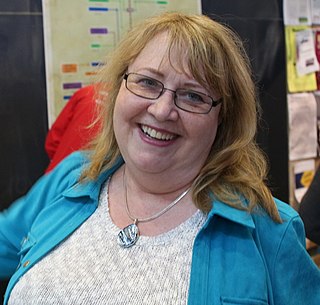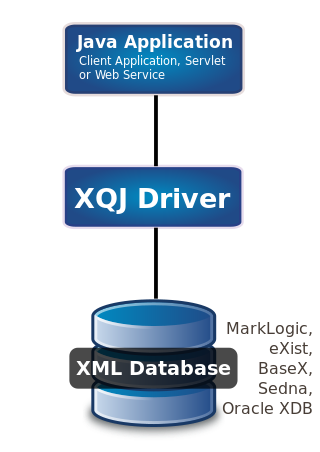
In computing, a database is an organized collection of data or a type of data store based on the use of a database management system (DBMS), the software that interacts with end users, applications, and the database itself to capture and analyze the data. The DBMS additionally encompasses the core facilities provided to administer the database. The sum total of the database, the DBMS and the associated applications can be referred to as a database system. Often the term "database" is also used loosely to refer to any of the DBMS, the database system or an application associated with the database.

An object database or object-oriented database is a database management system in which information is represented in the form of objects as used in object-oriented programming. Object databases are different from relational databases which are table-oriented. A third type, object–relational databases, is a hybrid of both approaches. Object databases have been considered since the early 1980s.
Structured Query Language (SQL) is a domain-specific language used in programming and designed for managing data held in a relational database management system (RDBMS), or for stream processing in a relational data stream management system (RDSMS). It is particularly useful in handling structured data, i.e., data incorporating relations among entities and variables.

Db2 is a family of data management products, including database servers, developed by IBM. It initially supported the relational model, but was extended to support object–relational features and non-relational structures like JSON and XML. The brand name was originally styled as DB/2, then DB2 until 2017 and finally changed to its present form.
IBM System R is a database system built as a research project at IBM's San Jose Research Laboratory beginning in 1974. System R was a seminal project: it was the first implementation of SQL, which has since become the standard relational data query language. It was also the first system to demonstrate that a relational database management system could provide good transaction processing performance. Design decisions in System R, as well as some fundamental algorithm choices, influenced many later relational systems.
A query language, also known as data query language or database query language (DQL), is a computer language used to make queries in databases and information systems. In database systems, query languages rely on strict theory to retrieve information. A well known example is the Structured Query Language (SQL).
eXist-db is an open source software project for NoSQL databases built on XML technology. It is classified as both a NoSQL document-oriented database system and a native XML database. Unlike most relational database management systems (RDBMS) and NoSQL databases, eXist-db provides XQuery and XSLT as its query and application programming languages.
An XML database is a data persistence software system that allows data to be specified, and sometimes stored, in XML format. This data can be queried, transformed, exported and returned to a calling system. XML databases are a flavor of document-oriented databases which are in turn a category of NoSQL database.

MonetDB is an open-source column-oriented relational database management system (RDBMS) originally developed at the Centrum Wiskunde & Informatica (CWI) in the Netherlands. It is designed to provide high performance on complex queries against large databases, such as combining tables with hundreds of columns and millions of rows. MonetDB has been applied in high-performance applications for online analytical processing, data mining, geographic information system (GIS), Resource Description Framework (RDF), text retrieval and sequence alignment processing.
An RDF query language is a computer language, specifically a query language for databases, able to retrieve and manipulate data stored in Resource Description Framework (RDF) format.

Raymond F. Boyce (1946–1974) was an American computer scientist who was known for his research in relational databases. He is best known for his work co-developing the SQL database language and Boyce-Codd normal form.
XQuery Update Facility is an extension to the XML Query language, XQuery. It provides expressions that can be used to make changes to instances of the XQuery 1.0 and XPath 2.0 Data Model.
Dan Suciu is a full professor of computer science at the University of Washington. He received his Ph.D. from the University of Pennsylvania in 1995 under the supervision of Val Tannen. After graduation, he was a principal member of the technical staff at AT&T Labs until he joined the University of Washington in 2000. Suciu does research in data management, with an emphasis on Web data management and managing uncertain data. He is a co-author of an influential book on managing semistructured data.

Patricia G. Selinger is an American computer scientist and IBM Fellow, best known for her work on relational database management systems.

Michael Ralph Stonebraker is a computer scientist specializing in database systems. Through a series of academic prototypes and commercial startups, Stonebraker's research and products are central to many relational databases. He is also the founder of many database companies, including Ingres Corporation, Illustra, Paradigm4, StreamBase Systems, Tamr, Vertica and VoltDB, and served as chief technical officer of Informix. For his contributions to database research, Stonebraker received the 2014 Turing Award, often described as "the Nobel Prize for computing."
XQuery is a query and functional programming language that queries and transforms collections of structured and unstructured data, usually in the form of XML, text and with vendor-specific extensions for other data formats. The language is developed by the XML Query working group of the W3C. The work is closely coordinated with the development of XSLT by the XSL Working Group; the two groups share responsibility for XPath, which is a subset of XQuery.
Richard Thomas Snodgrass is an American computer scientist and writer and is professor emeritus at the University of Arizona. He is best known for his work on temporal databases, query language design, query optimization and evaluation, storage structures, database design, and ergalics.
Sedna is an open-source database management system that provides native storage for XML data. The distinctive design decisions employed in Sedna are (i) schema-based clustering storage strategy for XML data and (ii) memory management based on layered address space.

XQuery API for Java (XQJ) refers to the common Java API for the W3C XQuery 1.0 specification.

Martin L. Kersten was a computer scientist with research focus on database architectures, query optimization and their use in scientific databases. He was an architect of the MonetDB system, an open-source column store for data warehouses, online analytical processing (OLAP) and geographic information systems (GIS). He has been (co-) founder of several successful spin-offs of the Centrum Wiskunde & Informatica (CWI).









